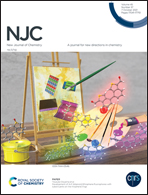Anti-algal activity of a fluorine-doped titanium oxide photocatalyst against Microcystis aeruginosa and its photocatalytic degradation†
Abstract
Harmful algae blooms represent a serious problem for natural waters around the world, and have a great impact on water quality, local economies and human health. To tackle the above challenge, we successfully prepare fluorine-doped titanium oxide (F-TiO2) nanocomposites by a hydrothermal method as a photocatalytic algaecide. The synthesized nanocomposites were characterized by SEM (scanning electron microscope), EDS (energy dispersive spectrometer), XPS (X-ray photoelectron spectroscopy), XRD (X-ray diffraction), and EPR (electron paramagnetic resonance). The results of this study indicated that the crystallinity of anatase in F-TiO2 is enhanced significantly upon fluorine doping. F-TiO2 with a dosage of 0.75 g L−1 exhibited the best anti-algae activity, and the removal rate of algae cells is above 97.5% under solar irradiation for 8 h. When the potential of hydrogen (pH) value was 10.0, F-TiO2 had a good treatment effect. When the pH value was lower than 6.25, it was beneficial to the decline of the chlorophyll a content. The inactivation process of F-TiO2 inhibiting Microcystis aeruginosa fits well with the improved Chick–Waston model and Hom model. During the photocatalytic destruction, fluorine-doped TiO2 oxidized the algae cell walls and membranes, simultaneously degrading the metabolic products and microcystin-LR with high efficiency. The reactive oxygen species contribution of the F-TiO2 photocatalyst in the process of photocatalytic algae removal is h+ > ˙OH > ˙O2−. Compared with traditional algae removal methods, photocatalytic algaecides can rapidly prevent secondary pollution while improving efficiency, and using solar light as an energy source is more suitable for in situ remediation of natural water bodies.



 Please wait while we load your content...
Please wait while we load your content...